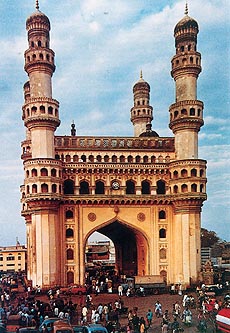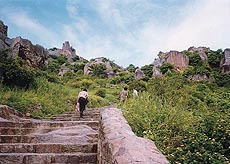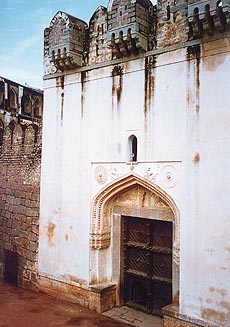Hyderabad
then and now
By Shona
Adhikari
RETURNING to Hyderabad after more
than 50 years was an experience that I had been looking
forward to. I had a faint recollection of the time I had
played on rocks at Secunderabad, during my father’s
posting at the Army cantonment there. Those rocks, warm
to the touch, were perhaps the earliest memories I had of
my childhood.
 Reaching Hyderabad late in the evening, I
decided to venture out early the next morning to get a
feel of the city, and visit Hyderabad’s most famous
monuments the Charminar and the area around it, before it
became too busy. Reaching Hyderabad late in the evening, I
decided to venture out early the next morning to get a
feel of the city, and visit Hyderabad’s most famous
monuments the Charminar and the area around it, before it
became too busy.
The Hyderabad that I saw
was very different from the one I had imagined. I drove
past the Raj Bhawan towards the enormous expanse of the
Husainsagar Lake. Along the way I saw amazingly modern
structures reaching skywards, but hardly any old houses.
The driver of my car was
obviously proud of the age of modernity that had arrived
in his city. Old monuments did not interest him much. But
he agreed to take me to the Charminar. The famous
stucture was every bit as imposing and spectacular as I
had imagined. The entire area was already bustling with
activity — children going to school with heavy
satchels on their backs, eateries around the square full
of people catching a quick bite on their way to work, burka-clad
women on foot and in autorickshaws and vendors with
hand-carts doing their utmost to attract all and sundry.
I was intrigued to find
that Charminar, which has a mosque on the upper level,
had a tiny temple tucked away on one side of its massive
base. A little ahead stood an ancient mosque with massive
gates, dating back to the times of the Charminar. In this
area, which for all purposes may be considered the very
heart of the city, time seemed to have stood still. It
was gratifying to find that’ at least here my mental
image of Hyderabad was still alive.
The streets around the
Charminar are narrow and four massive gates lead out from
the square. Many of the buildings that line the streets
and the square are at least 200 years old, having been
built by a succession of Nizams. While hoardings and
glowsigns indicate the year, the Charminar is much as it
was at the time when the Nizam’s legendary
photographer, Raja Din Dayal, took his famous photograph
of this historic monument.
The same evening we
again drove to Charminar when the sun was just setting.
My guide had a keen sense of history, and the Hyderabad
that I glimpsed through his eyes that evening was simply
fascinating.
 Following
the same route taken in the morning, we drove towards the
Husainsagar Lake. On the way we passed an unusual
structure that was still being built. It looked like a
castle out of a book of fairy tales, complete with turret
and gables, and even had a windmill on the side! The
building was Amruta Castle, and was planned to be a
hotel. It has been designed by a French architect, on the
lines of a castle at Germany. Following
the same route taken in the morning, we drove towards the
Husainsagar Lake. On the way we passed an unusual
structure that was still being built. It looked like a
castle out of a book of fairy tales, complete with turret
and gables, and even had a windmill on the side! The
building was Amruta Castle, and was planned to be a
hotel. It has been designed by a French architect, on the
lines of a castle at Germany.
The Husainsagar lake
built and named after Husain Wali, and architect from
Baghdad, has been the main water body in the city for
centuries. A large statue of the Buddha was erected in
the middle of the lake. Boating and yachting clubs are
situated on the banks and it is possible to sail all the
way to the statue. Along the lake runs the wide Tank Bund
Road, with larger than life sized figures of Andhra
heroes, and historical and mythical figures lining one
side. The road connects Hyderabad with its twin city
Secunderabad.
We passed a whole array
of Parsee bakeries, that are said to make the most
amazing breads. Further down the road is Paradise Circle,
full of a large number of Irani restaurants, serving what
my guide calls a decent Biryani.
The new shopping
complex, Swapnalok, is situated right next to shops that
are over 100 years old. Available nearby is Abdul
Kader’s amazing cut-glass —a must for
discerning city shopper as well as outstation visitors.
For traditional Andhra
food, ‘Abhiruchi’ is one of the best places,
while the nearby ‘Chat Corner’ also does brisk
business. More serious diners choose to eat at
Hyderabad’s oldest Chinese restaurant— Nanking.
 Telugu language is the common
platform for the people of Telengana, Rayalseema and
Andhra. While there are many wealthy old residents of the
city, a large number of new settlers from Tamil Nadu have
moved to Hyderabad. Telugu language is the common
platform for the people of Telengana, Rayalseema and
Andhra. While there are many wealthy old residents of the
city, a large number of new settlers from Tamil Nadu have
moved to Hyderabad.
We next came to the
Fateh Maidan. This is the spot where prior to the seige
of the Golconda Fort, the army was defeated by the
Mughals. The Golconda army is said to have included many
Dakhani Sikhs, darker in complexion than their brethren
in the north. The descendents of these legendary Sikhs
still live in a special Sikh village.
The sizable Parsee
population of Hyderabad lives around Pendegast Road. Due
to their close links with the Nizams for generations, the
Parsees of the city have a lifestyle different from those
in Bombay. On ceremonial occasions they wear Muslim-style
achkans and headgear.
The Hyderabad Public
School is a gracious structure built by the Nizams. On
the left is the Country Club, which was earlier the home
of Bashir Jha.
There is much more to
Hyderabad that deserves mention. Among the places worth
seeing are the Legislative Assembly building, Osmania
University, with its sprawling campus, Telugu University,
Osmania General Hospital and the gracious High Court
building. On top of a rocky hill stands the Birla Mandir,
and nearby is the Birla Planetarium-cum-Science Centre.
The Salarjung Museum
houses an amazing collection of rare and unusual art
objects collected by Nawab Salar Jung 111, and is
definitely worth a visit.
For those with a
historical bent of mind, a visit to Hyderabad would not
be complete without seeing the famous Golconda Fort. Just
a half hour’s drive from the city, the fort is the
venue of an exciting sound and light show on the life and
times of the Qutab Shahi Dynasty.
Hyderabad is all this
and more — a city with a great historical past, but
ready to move on to the 21st century with vigour.
|

